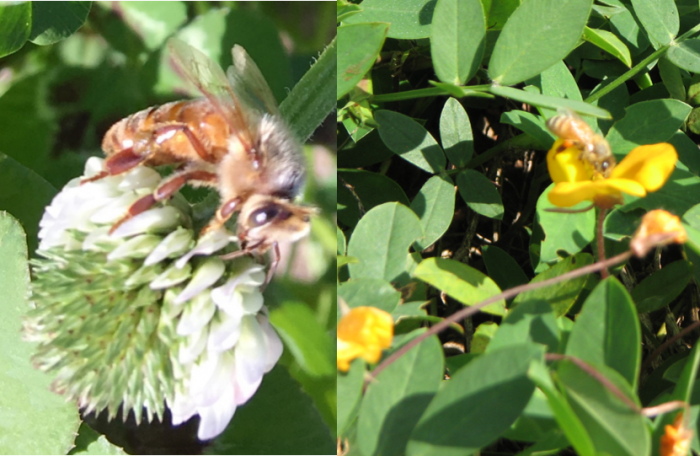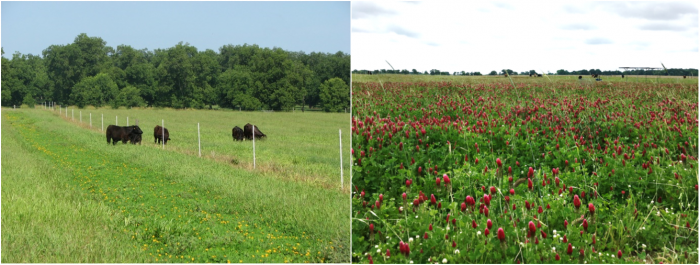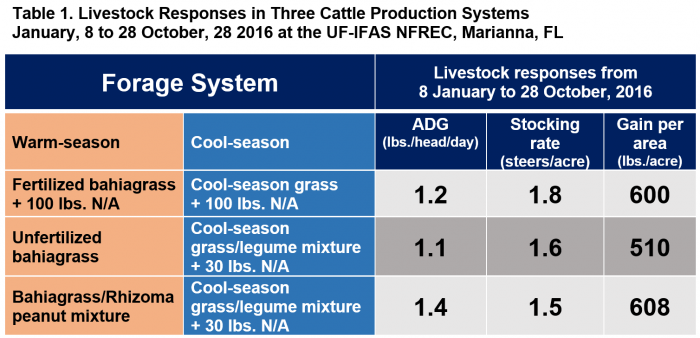Jose Dubeux, Liza Garcia, David Jaramillo, Erick Santos, UF/IFAS North Florida Research and Education Center
You might not be familiar with the term “Ecosystem Services,” but putting it simply, these are the benefits obtained from ecosystems (interactions between living organisms in a particular environment). These services benefit both people and the environment. Ecosystem services (ES) provided by grasslands include not only products such as beef and milk (provisioning ES), but also biological nitrogen fixation (N2-fixation) and nutrient cycling (supporting ES), carbon sequestration and greenhouse gas mitigation, water capture and purification, shade, windbreaks, habitat for pollinators and wildlife (regulating ES), and finally cultural (e.g. habitat for wildlife), and aesthetic ES.
Grassland managers are providing all these benefits to society, and they ought to receive compensation for that. Payment mechanisms might work in various ways, including tax breaks, direct monetary compensation, and cost-share programs. The first step, however, is to quantify and assign a monetary value to these ES. Researchers at the University of Florida are trying to accomplish this through a USDA-funded project currently being conducted in Marianna and Gainesville, Florida.

Figure 1. Honeybee on white clover flower in Citra, FL (left) and on rhizoma peanut (perennial peanut) flower in Marianna, FL (right). Photo credit: Jose Dubeux
When legumes are integrated into grass pastures, the potential to provide additional ES is increased. Legumes are able to fix atmospheric-N2 by associating with soil bacteria (reducing N-fertilizer input as a result), provide flowers for pollinators (Figure 1 above), and improve forage quality. Preliminary data indicate that 12 different bee species benefit from grass-legume pastures in Marianna. Adding legumes might also increase primary productivity in low-input systems, with grass-legume mixtures outperforming monocultures, enhancing nutrient cycling and carbon sequestration.

Figure 2. Typical in vitro organic matter digestibility (IVOMD) and crude protein (CP) of bahiagrass and rhizoma peanut.
Forage legumes are often more digestible and have greater crude protein than grasses (Figure 2 above). This often results in greater livestock performance when grazing on grass-legume pastures as opposed to grass monocultures (Figure 3 below).

Figure 3. Livestock performance (average daily gain – ADG) on unfertilized Bahiagrass, N-fertilized Bahiagrass (100 lbs. N/acre), and Bahiagrass-rhizoma peanut pastures (Dubeux et al., 2016).
Currently researchers at North Florida Research and Education Center in Marianna are assessing the ES provided by N-fertilized grasses and grass-legume systems . Grass-legume systems of Bahiagrass-rhizoma peanut pastures in the summer are overseeded with cool-season grasses (rye and oat) and clovers (crimson, red, and ball) over the winter (Figure 4 below).

Figure 4. Grass-legume pastures in Marianna, FL. On the left, warm-season mixture with Argentine bahiagrass and Ecoturf rhizoma peanut; on the right, cool-season mixture with cool-season grasses and clovers. Photo credit: Jose Dubeux
Preliminary results indicate similar livestock gains for grass-legume systems fertilized only with only 30 lbs. of nitrogen per acre, compared to grass only systems fertilized with 200 lbs. N/acre (Table 1).
 Other ecosystem services are currently being assessed in the same project. A multidisciplinary team is working on different aspects of grassland ecosystems, including soil, vegetation, livestock, bees, water quality, and economics. At the end of the project, the hope is to provide comprehensive information on all these aspects.
Other ecosystem services are currently being assessed in the same project. A multidisciplinary team is working on different aspects of grassland ecosystems, including soil, vegetation, livestock, bees, water quality, and economics. At the end of the project, the hope is to provide comprehensive information on all these aspects.
Take Home Message
Grasslands produce far more than beef and milk. They provide additional ecosystem services (ES) that benefit society. Integrating forage legumes into grasslands enhances the capacity to provide these benefits. In Marianna, researchers are assessing an array of ES provided by N-fertilized grass and also by grass-legume pastures. Preliminary results indicate the possibility to produce similar livestock gains in grass-legume pastures using only 15% of the N-fertilization typically used in grass monocultures. Other ES such as presence of bees, carbon sequestration, and mitigation of greenhouse gases are also being assessed. The goal is to quantify the economic value for these different ES provided by grazing systems. Public policies could then be established to provide financial incentives to livestock producers through conservation programs. Hopefully these incentives would at least offset some of the cost of establishment for grass-legume systems on farms. With ES benefits more clearly defined, this could become a win-win situation, both for society and for the land owner.
References:
Dubeux, J.C.B., Jr., L. Garcia, N. DiLorenzo, C. Prevatt, A. Blount, C. Mackowiak, E. Santos, D. Jaramillo, M. Ruiz-Moreno. 2016. Reduce your N fertilizer cost and maintain cattle productivity by planting forage legumes. The Florida Cattlemen and Livestock Journal, December 2016, v.81, n.3, p.94-97.
- Grazing Cover Crops is a Triple Win! - August 15, 2025
- How are My Cool-season Forages Recovering from the Snowfall and Low Temperatures? - January 31, 2025
- Integrated Crop-Livestock Systems Improve Soil Health - July 26, 2024
